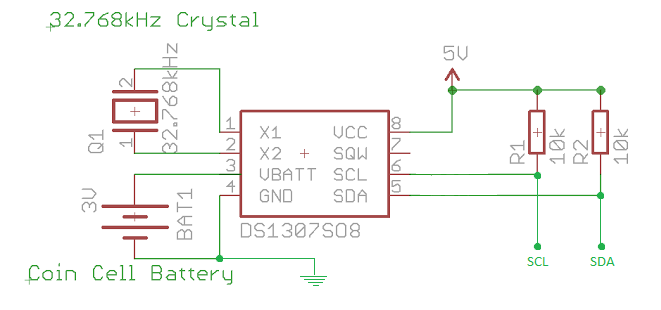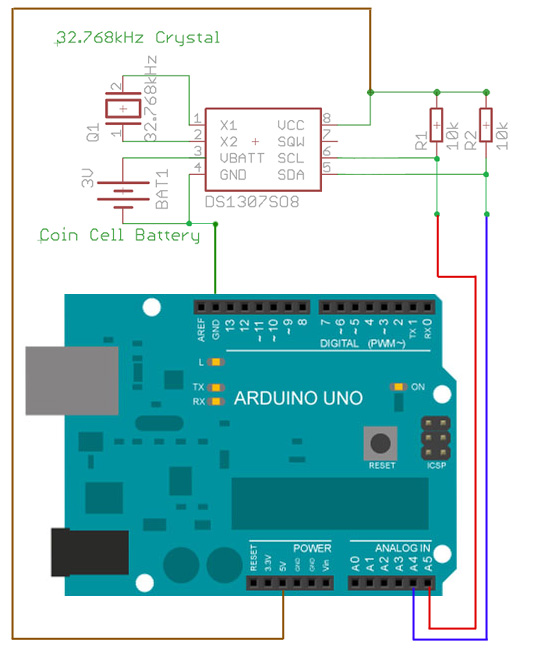Hello friends, today I am going to build a Digital Clock using Arduino UNO and famous DS1307 Real Time Clock IC.
2) DS1307 RTC IC
DS1307 is a low power serial real time clock with full binary coded decimal (BCD) clock/calendar plus 56 bytes of NV SRAM.
The DS1307 IC uses I²C protocol to transfer data to the Microcontroller.
3) What is I²C Protocol?
I²C (Inter-Integrated Circuit), pronounced I-squared-C, is a multi-master, multi-slave, single-ended, serial computer bus invented by Philips Semiconductor, known today as NXP Semiconductors, used for attaching low-speed peripherals to computer motherboards and embedded systems. Alternatively I²C is spelled I2C (pronounced I-two-C) or IIC (pronounced I-I-C).
4) DS1307 Circuit
Before we begin, you have to build a small circuit with some components. Other than the DS1307 IC, you need following components to build this small circuit. This circuit is also available as a completed board. You can search on eBay and other famous electronic shopping web sites for more information.
DS1307 is a low power serial real time clock with full binary coded decimal (BCD) clock/calendar plus 56 bytes of NV SRAM.
The RTC provides year, month, date, hour, minute and second information. The end date of months is automatically adjusted for months fewer than 31 days including leap year compensation up to year 2100. It can operate either in 24-hour format or 12-hour format with AM/PM indicator. Below are the key features of this IC.
- Real-Time Clock (RTC) Counts Seconds, Minutes, Hours, Date of the Month, Month, Day of the week, and Year with Leap-Year Compensation Valid Up to 2100
- 56-Byte, Battery-Backed, General-Purpose RAM with Unlimited Writes
- I²C Serial Interface
- Programmable Square-Wave Output Signal
- Automatic Power-Fail Detect and Switch Circuitry
- Consumes Less than 500nA in Battery-Backup Mode with Oscillator Running
- Optional Industrial Temperature Range: -40°C to +85°C
- Available in 8-Pin Plastic DIP or SO
The DS1307 IC uses I²C protocol to transfer data to the Microcontroller.
3) What is I²C Protocol?
I²C (Inter-Integrated Circuit), pronounced I-squared-C, is a multi-master, multi-slave, single-ended, serial computer bus invented by Philips Semiconductor, known today as NXP Semiconductors, used for attaching low-speed peripherals to computer motherboards and embedded systems. Alternatively I²C is spelled I2C (pronounced I-two-C) or IIC (pronounced I-I-C).
4) DS1307 Circuit
Before we begin, you have to build a small circuit with some components. Other than the DS1307 IC, you need following components to build this small circuit. This circuit is also available as a completed board. You can search on eBay and other famous electronic shopping web sites for more information.
- 10k Resistors – 2 [pull up resistors]
- 32.768 KHz Crystal Oscillator
- 3V coin cell battery [to provide backup power]
Please use the following schematic to build the DS1307 circuit.
5) Let’s connect DS1307 circuit to your Arduino UNO
After you completed the above circuit, it is time to connect this circuit to Your Arduino UNO. Please use the following configurations table to connect your DS1307 circuit to Arduino UNO
Following schematic will help you to further understand the pin configurations.
6) The RTClib.h
We are going to use a special library called the RTClib and in it there’s an example sketch which sets the time on the DS1307 IC. Upon the first power up, the DS1307 will start counting from 1/1/2000 0:00 which is not right, so we need to set it up to the correct date and time. We’ll only need to do this once as long as the coin cell battery is not removed.
You can download the library from below Link
If you are not familiar adding new libraries to Arduino IDE, please follow the tutorial in below link.
How to add new libraries to Arduino IDE
7) Source Code for the Step 1
As I mentioned in the introduction of this tutorial, first we are going to test our real time clock using the Serial Monitor window of the Arduino IDE. Later we will connect our circuit to a LCD screen.
#include <Wire.h> #include "RTClib.h" RTC_DS1307 RTC; void setup () { Serial.begin(9600); Wire.begin(); RTC.begin(); if (! RTC.isrunning()) { Serial.println("RTC is NOT running!"); RTC.adjust(DateTime(F(__DATE__), F(__TIME__))); } } void loop () { DateTime now = RTC.now(); Serial.print(now.year(), DEC); Serial.print('/'); Serial.print(now.month(), DEC); Serial.print('/'); Serial.print(now.day(), DEC); Serial.print(' '); Serial.print(now.hour(), DEC); Serial.print(':'); Serial.print(now.minute(), DEC); Serial.print(':'); Serial.print(now.second(), DEC); Serial.println(); delay(1000); }
8) Connecting 16x2 LCD Screen to the ProjectWhat this code does is basically sets the time and date according to when the sketch is compiled. Of course there will be a slight delay from the time the code compiles and it is fully uploaded to the Arduino. I think it’s less of a problem on the newer Arduinos that are using the Atmel 8U2 and 16U2 as the upload times are significantly faster.Now open the serial monitor of the Arduino IDE to see the output. Here is a screenshot of my output. Click on the image to enlarge.
If you are succeed with the above experiment, now it is time to build a fully working Digital Clock using a LCD screen. You can use the same circuit you built earlier in the first step. Only difference is, instead of using the serial monitor, this time we are going to use a LCD screen to display the time.
Please use the following schematic to connect 16x2 HD44780 compatible LCD screens to your Arduino UNO board.
Please make sure you keep the previous circuit connections as it is. Connect your LCD to Arduino. Other than the connections in the above diagram, you have to connect Ground and +5V connections from LCD to Arduino accordingly
If you are not familiar with connecting LCD screens to Arduino, please refer a tutorial to update your knowledge.
9) Source Code for the Step 2
Add the following sketch to Arduino IDE and upload it to the Arduino UNO board. Please compare this code with the previous code, so that you can understand the differences.
#include <Wire.h> #include "RTClib.h" #include <LiquidCrystal.h> RTC_DS1307 RTC; LiquidCrystal lcd (7, 8, 9, 10, 11, 12); void setup () { Serial.begin(9600); lcd.begin(16, 2); Wire.begin(); RTC.begin(); if (! RTC.isrunning()) { Serial.println("RTC is NOT running!"); RTC.adjust(DateTime(F(__DATE__), F(__TIME__))); } } void loop () { DateTime now = RTC.now(); lcd.setCursor(0,0); lcd.print("TIME: "); lcd.print(now.hour(), DEC); lcd.print(":"); lcd.print(now.minute(), DEC); lcd.print(":"); lcd.print(now.second(), DEC); lcd.setCursor(0,1); lcd.print("DATE: "); lcd.print(now.year(), DEC); lcd.print("/"); lcd.print(now.month(), DEC); lcd.print("/"); lcd.print(now.day(), DEC); delay(1000); }
If you are successfully connect your LCD and upload the above source code, now you should be able to see the time on your LCD screen. This is the end of this awesome project. Below you can see the YouTube video of my project.
10) Conclusion
If you are not familiar with connecting LCD screens to Arduino, please refer some tutorials to familiar with that.
There are no any push button switches added to the circuit to adjust the time. It is going beyond the scope of this tutorial. You can try out this in your leisure time.
In this tutorial, I haven’t described in detail how Arduino actually communicate with DS1307 via the I2C protocol. Please refer some books or website to understand the I2C protocol in detail.
If you have any problems, please comment on this page. I will try to help my best.
References
I referred several web pages to create this tutorial. Following are some of them. You can refer them and update your knowledge.
http://waihung.net/ds1307-real-time-clock-ic/
http://en.wikipedia.org/wiki/I%C2%B2C
http://www.electroschematics.com/8921/digital-clock-with-arduino-and-ds1307/
Thank you and have a nice day!








No comments:
Post a Comment